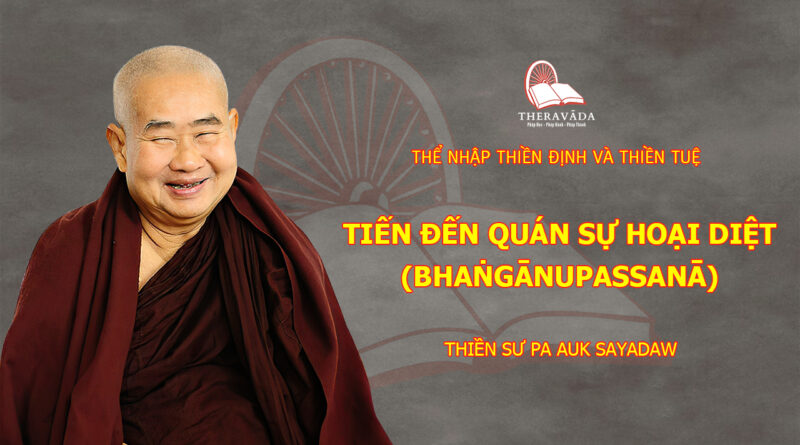Proceeding to Baṅgānupassanā
(Contemplation of Dissolution)
|
Tiến Đến Quán Sự Hoại Diệt(Bhaṅgānupassanā)
|
| When he repeatedly observes in this way, examines and investigates mentality-materiality, causes and effects, to see that they are impermanent, painful, not-self and repulsive, his preceding meditation knowledge connects with his subsequent meditation knowledge. So his insight knowledge (vipassanāñāṇa) becomes very strong, very keen, sharp and pure. He no longer exteneds his mindfulness to their arising but brings it to bear on their dissolution. |
Khi hành giả lặp lại quan sát theo cách này, xem xét và thẩm sát danh-sắc, các nhân và quả để thấy rằng chúng là vô thường, khổ, vô ngã và bất tịnh, trí tuệ thiền đi trước liên kết với trí tuệ thiền đi sau. Như vậy, tuệ minh sát(vipassanāñāṇa) của hành giả trở nên rất mạnh mẽ và rất sắc sảo, bén nhọn và thuần khiết. Hành giả không còn mở rộng niệm đến sự sanh mà đem nó hướng đến sự tan rã của chúng. |
| “Khaya vaya bheda nirodheyewa satisantiṭṭhati”167 |
“Khaya vaya bheda nirodheyewa satisantiṭṭhati”168 |
| “With the powerful support of the preceding insight knowledge the mindfulness associated with the subsequent insight knowledge becomes well established on the fading away, dissolution and cessation of formations.” |
“Với sự hỗ trợ đầy sức mạnh của tuệ minh sát đi trước, niệm kết hợp với tuệ minh sát đi sau trở nên khéo an trú trên tính tàn lụi, tan rã và hoại diệt của các hành.” |
| (1) Aniccaṁ khayaṭṭhena – observing the nature of fading away, breaking up, dissolving and disappearing of formations with direct knowledge, he reflects “anicca, anicca” repeatedly. |
(1) Aniccaṁ khayaṭṭhena – quan sát bản chất tàn lụi, tan vỡ, tan rã và biến mất của các hành bằng thắng trí, hành giả quán xét “anicca, anicca” (vô thường, vô thường) lặp đi, lặp lại. |
| (2) Dukkhaṁ bhayaṭṭhena-observing the frightful nature of fading away, breaking up, dissolving and disappearing of formations with direct knowledge, he reflects “dukkha, dukkha” repeatedly. |
(2) Dukkhaṁ bhayaṭṭhena – quan sát bản chất khủng khiếp của tàn lụi, tan vỡ, tan rã và biến mất của các hành bằng thắng trí, hành giả quán xét “dukkha, dukkha” (khổ, khổ) lặp đi, lặp lại. |
| (3) Anattā asārakaṭṭhena – observing the coreless, selfless and soulless nature of formations with direct knowledge, he reflectes “anatta, anatta” repeatedly. |
(3) Anattā asārakaṭṭhena – quan sát bản chất không có cốt lõi, không có tự ngã và không có linh hồn của các hành bằng thắng trí, hành giả quán xét “anatta, anatta” (vô ngã, vô ngã) lặp đi, lặp lại. |
| (4) He also reflects on the repulsive nature of formations intermittently. |
(4) Hành giả cũng quán xét bản chất bất tịnh của các hành vào từng lúc. |
| As he has broken the compactness of mentality and materiality by penetrating into the ulimate realities in mental groups and rūpakalāpas when he developed nāmarupaparicchedañāṇa and the purification of view, rūpakalāpas are now no longer distinct. Since his insight knowledge is very keen and sharp, the ultimate realities (paramattha dhammas) of formations become very quickly distinct in his knowledge. As they appear and dissolve so quickly that he could no longer observe their arising and existing; he observes only their dissolution. |
Khi hành giả đã phá vỡ tính khối của danh và sắc bằng cách thấu suốt vào các pháp chân đế trong nhóm danh và nhóm sắc(rūpakalāpa) khi tu tập Tuệ Xác Định Danh-Sắc(nāmarūpaparicchedañāṇa) và kiến thanh tịnh, bây giờ, nhóm sắc (rūpakalāpa) không còn rõ ràng nữa. Vì tuệ minh sát của hành giả rất sắc sảo và bén nhọn, các pháp chân đế(paramattha dhamma) của các hành trở nên rất nhanh chóng rõ ràng trong trí tuệ của hành giả. Vì chúng xuất hiện và tan rã quá nhanh đến nỗi hành giả không còn có thể quan sát được sự sanh và hiện hữu của chúng nữa; hành giả chỉ quan sát thấy sự hoại diệt của chúng. |
| This ‘knowledge of contemplation of dissolution’ is called ‘bhaṅgañāṇa’. |
“Tuệ quán sự hoại diệt” này được gọi là “bhaṅgañāṇa”. |
